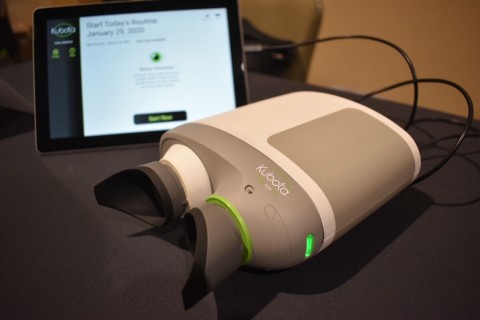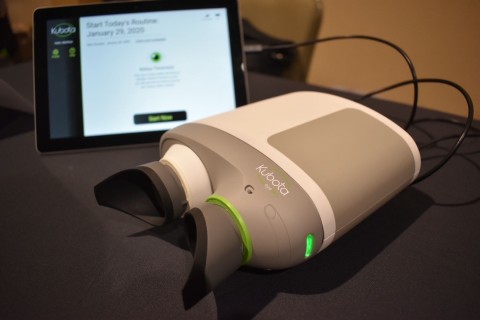SEATTLE--(BUSINESS WIRE)--Acucela Inc. (“Acucela”), a clinical-stage ophthalmology company and wholly-owned subsidiary of Kubota Pharmaceutical Holdings Co., Ltd. (Tokyo 4596), announced today that the company was invited to meet with NASA and the Translational Research Institute for Space Health (TRISH)*1 to present on January 30, 2020 the status of its Swept Source-OCT*2 (“SS-OCT”) device being developed for NASA’s Deep Space missions.
The purpose of the meeting was to review and discuss progress of this Phase 1 project with the engineers, basic and medical scientists and program managers from NASA and TRISH. Additionally, a demonstration of the Phase 1 device was presented at the meeting.
On March 17, 2019, Acucela signed an agreement with TRISH to develop a compact OCT device for NASA’s Deep Space missions. (See press release titled “Acucela Signs Agreement to Develop a Compact OCT for NASA’s Deep Space Missions.”)
According to a recent research study by NASA, approximately 69% of long-duration spaceflight crewmembers present with one or more signs of Spaceflight Associated Neuro-ocular Syndrome (SANS), including optic disc edema, globe flattening, choroidal folds, cotton wool spots, and refractive shifts. OCT has become a mainstay of crew testing for SANS because it allows accurate measurement of retinal thickness and cross-sectional imagery of the retina and optic disc. This, in combination with other tests, provides the necessary data to diagnose, monitor, and eventually treat SANS.
The commercially available off-the-shelf OCT devices currently deployed to the International Space Station (ISS) are not suitable for Lunar, Martian, and other expeditionary space travel. These commercial systems are complex, too large, not radiation hardened, require an additional specially trained operator, and contain features that are not necessary for diagnosing and monitoring the anatomic effects of SANS.
“Your handheld OCT device is quite impressive with its small size, ease of use and its speed in data acquisition. A device such as this could be quite helpful on the International Space Station aiding NASA in its quest for understanding how spaceflight affects some of our astronauts' eyes,” said William J. Tarver, MD, MPH, FAsMA, SANS Clinical Lead – CNS, NASA Flight Surgeon.
Also, CAPT Tyson Brunstetter, OD, PhD, MBA, FAAO, FAsMA, MSC, U.S. Navy, DoD Aerospace Medical Liaison, NASA SANS Clinical Lead - Eyes/Vision, stated, “I came away this week thoroughly impressed with the progress made on this TRISH-funded SS-OCT Proof-of-Concept device; all Phase 1 goals were not only attained, but surpassed.” Dr. Brunstetter continued, “Physically, it has the appearance of a polished, commercially-available product, and it rests lightly and comfortably in your hands, like a pair of binoculars. With all of this early progress in mind, I am truly excited to see the Phase 2 deliverable.”
Ryo Kubota, MD, PhD, NASA Human Research Program (HRP) Investigator, Chairman, President and CEO of Acucela Inc., said, “I am very pleased with what we have accomplished for the Phase 1 project with demonstration of what our OCT device can do. During the meeting, we asked some of the NASA team to try the device themselves to test how it worked. They were very excited to see how easy it was to operate and how fast the image of the data became available.” Dr. Kubota continued, “With current OCT devices, the whole process takes about 90 minutes total to set up, measure, and obtain the data in the ISS, and it requires a technician to obtain the images of the patient’s eye. However, our OCT device takes only a few minutes and is operated by the person being imaged. Currently, only a few OCT measurements are being done in the ISS per flight, but because of the convenience and the speed of our device, we can measure the retina much more frequently. Thus, our device will provide much better temporal resolution; and if our device is deployed on the ISS, it will help NASA learn a lot about how SANS may develop. We will continue advancing our innovative technology to lead to a successful development.”
A final technical and progress report on this Phase 1 project will be due 60 days after the end of its performance period, which is February 29, 2020.
*1 TRISH is an academic consortium led by Baylor College of Medicine and includes the California Institute of Technology and Massachusetts Institute of Technology. The mission of TRISH is to lead a natural effort in translating cutting edge emerging terrestrial biomedical research and technology development into applied space flight human risk mitigation strategies for human exploration mission.
*2 OCT (Optical Coherence Tomography) is a non-invasive tool that uses light waves to take cross-sectional pictures of the retina.
About Acucela Inc.
Acucela Inc. is a wholly-owned subsidiary of Kubota Pharmaceutical Holdings Co., Ltd. (Tokyo 4596) committed to translating innovation into a diverse portfolio of drugs and devices to preserve and restore vision for millions of people worldwide. Acucela’s development pipeline include drug candidates for the treatment of diabetic retinopathy, Stargardt disease, and optogenetics-based gene therapy for the treatment of retinitis pigmentosa. The company is also developing a handheld OCT device for the monitoring of neovascular retinal diseases, to be used directly by patients. https://www.acucela.com; https://www.kubotaholdings.co.jp/en/
Cautionary Statements: https://www.kubotaholdings.co.jp/en/1/index.html
“Acucela”, the Acucela logo and “Kubota” are registered trademarks or trademarks of Acucela Inc. or Kubota Pharmaceutical Holdings in various jurisdictions.




